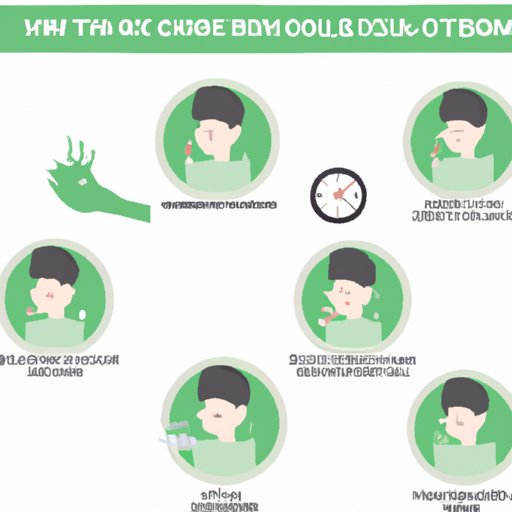
Introduction
E. coli, short for Escherichia coli, is a bacterium that normally lives in the gut of humans and animals. While most strains of E. coli are harmless, some can cause serious illnesses that can lead to kidney damage or even death. Understanding the speed at which E. coli symptoms manifest is crucial to preventing its spread and providing proper medical care. In this article, we will explore how fast E. coli symptoms can appear and what steps you can take to protect yourself from infection.
Investigating E. coli: Understanding the Speed of Symptom Onset
Knowing how quickly E. coli symptoms show up is important for several reasons. First, because E. coli can cause serious illness, knowing when to seek medical attention is crucial. Second, because E. coli is highly contagious, identifying and quarantining outbreaks quickly is essential for stopping its spread.
One factor that can affect the speed of symptom onset is the patient’s immune system. Patients with weakened immune systems may take longer to develop symptoms or may experience more severe symptoms than healthy patients. In addition, the strain of E. coli bacteria that causes the illness can also affect the speed of onset. Some strains of E. coli are more virulent than others and can cause symptoms to appear more quickly.
The Science Behind E. coli: How Fast Does it Show Up?
There are many strains of E. coli, and not all of them cause illness in humans. Some strains, like those found in the gut, are even beneficial to the digestive system. However, certain strains of E. coli, such as E. coli O157:H7, can produce dangerous toxins that cause severe illness.
The mechanism behind how E. coli infects the body and starts causing symptoms is not yet fully understood. However, researchers believe that the bacteria attach themselves to the lining of the intestines, where they produce toxins that cause inflammation. This inflammation can lead to a range of symptoms, including diarrhea, vomiting, and fever.
From Contamination to Onset: Tracing the Timeline of E. coli Symptoms
E. coli is typically spread through contaminated food or water. The bacteria can be present in raw or undercooked meat, unpasteurized milk, and fresh produce that has been contaminated with animal feces. When a person ingests the bacteria, it begins to multiply in the intestines, releasing toxins that cause symptoms to appear.
The timeline for when E. coli symptoms start to appear can vary depending on the patient and the specific strain of bacteria. In most cases, symptoms appear within two to five days after exposure, but it can take as little as one day or as long as 10 days for symptoms to appear. Patients who are infected with E. coli O157:H7 may experience symptoms more quickly and more severely than those infected with other strains of E. coli.
E. Coli: The Silent Bacteria That Strikes Quickly
While some strains of E. coli may cause only mild symptoms, others can be extremely serious. In severe cases, E. coli can lead to kidney failure and even death. This is why it’s important not to underestimate the potential harm of E. coli and to seek medical attention promptly if symptoms appear.
In addition to kidney damage, severe cases of E. coli can also cause anemia, seizures, and paralysis. This is why it’s important to take steps to prevent infection in the first place, including washing your hands regularly, avoiding undercooked meat and unpasteurized dairy products, and washing fresh produce thoroughly before eating it.
The Fast and Furious Symptoms of E. Coli: What You Need to Know
Common symptoms of E. coli include abdominal cramps, diarrhea (often bloody), nausea, vomiting, and fever. In more severe cases, patients may experience dehydration, kidney failure, and anemia. Symptoms can progress quickly, so it’s important to be aware of warning signs and to seek medical attention if necessary.
In some cases, E. coli symptoms can linger for several weeks or even months. This can be especially true of patients who have developed kidney damage or other serious complications. In these cases, patients may require hospitalization and ongoing medical care.
When Time is of the Essence: Understanding the Urgency of E. Coli Symptom Onset
If you think you may have been exposed to E. coli or are experiencing symptoms, it’s important to seek medical attention as soon as possible. Your doctor may recommend diagnostic tests to confirm the presence of E. coli and may prescribe antibiotics to help fight the infection.
It’s important to note that antibiotics are not always effective in treating E. coli infections. In some cases, they can even make the infection worse. This is why it’s important to work closely with your doctor and to follow their recommendations carefully.
Conclusion
E. coli is a serious illness that can cause severe complications if left untreated. Understanding the speed at which symptoms appear and knowing what warning signs to look for can help you protect yourself and your loved ones from infection. It’s important to take steps to prevent infection in the first place, including washing your hands regularly, avoiding undercooked meat and unpasteurized dairy products, and washing fresh produce thoroughly before eating it. If you do experience symptoms, seek medical attention promptly to ensure the best possible outcome.





